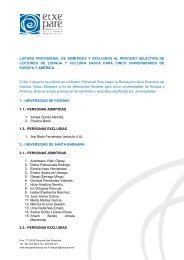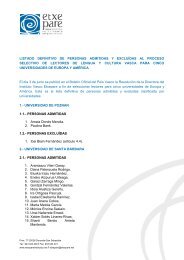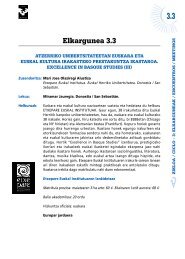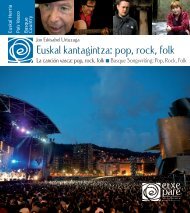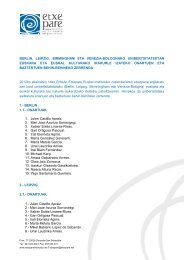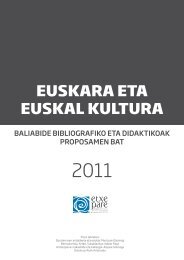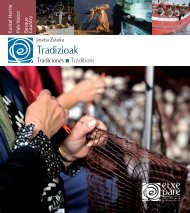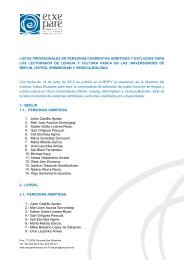Euskal sukaldaritzaz - Etxepare, Euskal Institutua
Euskal sukaldaritzaz - Etxepare, Euskal Institutua
Euskal sukaldaritzaz - Etxepare, Euskal Institutua
You also want an ePaper? Increase the reach of your titles
YUMPU automatically turns print PDFs into web optimized ePapers that Google loves.
te siglos de los mejores–, se han de hacer a la chita<br />
callando. El caso es que, por ejemplo, cuando Jacques<br />
Cartier descubrió la bahía de San Lorenzo por órdenes<br />
de Francisco I de Francia, había allí más de un millar<br />
de barcos vascos reunidos, según cuentan las crónicas.<br />
Fue el bacalao en salazón quien libró a la gente de<br />
tener que comer, como hasta entonces, carne de ballena<br />
por Cuaresma. Por lo visto, la grasa de este mamífero<br />
era extraordinaria, ya que una vez que se fundía,<br />
no se volvía a solidificar, pero tener que comer<br />
su carne durante días era otro cantar. Para comer lo<br />
mejor de la ballena era la lengua, que se asaba a la<br />
parrilla y se servía con guisantes o, si no, se salaba<br />
y vendía como el tocino. Lo demás, si se tenía que<br />
comer se comía pero sin que a nadie hiciera mucho<br />
tilín. El bacalao, en cambio, era y es una de nuestras<br />
glorias culinarias más apreciadas.<br />
Como ya hemos dicho, las grandes campañas del bacalao<br />
no son ya más que historia. Nuestros pescadores<br />
de hoy sacan sus cuartos prácticamente con tres<br />
campañas que se presentan a lo largo del año: en primavera<br />
anchoa y txitxarro (jurel) y, sobre todo, atún<br />
en verano. Es bien cierto que también se capturan<br />
otras especies a lo largo del año, sobre todo merluza,<br />
pero lo que hace que un año sea o no bueno económicamente,<br />
es hoy el atún.<br />
Es por ello que la primera receta de las cinco que presentamos<br />
en este texto, viene dedicada a este pescado,<br />
que llega a nuestras costas en sus primeros años,<br />
antes de llegar a la madurez sexual y reproductiva.<br />
Hablamos de dos pescados azules, del atún (Tunnus<br />
thynnus) y del bonito (Tunnus alalunga) , las dos especies<br />
básicas para la economía de nuestros pescadores<br />
contemporáneos, y de un plato muy socorrido<br />
que aquellos pescadores se veían obligados a cocinar<br />
a bordo en los largos viajes: el marmitako.<br />
No es nada del otro mundo, ni se trata de un plato<br />
excelso. Es, digámoslo, una popular caldereta de<br />
pescado y verduras que apenas si se encuentra en las<br />
cartas de los restaurantes más refinados, pero que<br />
the quiet. The fact of the matter is that, for example,<br />
when Jacques Cartier discovered the Gulf of Saint<br />
Lawrence on the orders of Francis I of France, there<br />
were over a thousand Basque ships there, according<br />
to the chronicles.<br />
Salted cod freed people from having to eat, as had<br />
been customary to that time, whale meat for Lent.<br />
Apparently, the fat of this mammal was extraordinary,<br />
given that once it melted it never solidified<br />
again, but having to eat its meat day after day was<br />
another thing. The best part of the whale was its<br />
tongue, which was grilled and served with peas, or<br />
if not cooked, salted and sold as lard. The rest of it<br />
was, if necessary, eaten but without it doing much<br />
for anyone. Cod, by contrast, was and is one of our<br />
most appreciated culinary glories.<br />
As noted, the big cod companies are history now. It<br />
takes only three seasons a year today for our fishermen<br />
to practically reach their quotas: in the spring<br />
they fish for anchovies and horse-mackerel and, especially,<br />
tuna in the summer. It is also true that they<br />
catch other kinds of fish throughout the year, especially<br />
hake, but what makes or breaks a year financially<br />
speaking is, today, tuna.<br />
For this reason, the first of five recipes offered here<br />
is dedicated to this fish, which arrives in our waters<br />
at an early age, before it has reached sexual and reproductive<br />
maturity. I am referring to two blue fish,<br />
Northern or Atlantic bluefin tuna (Thunnus thynnus)<br />
and Albacore tuna or bonito (Thunnus alalunga), the<br />
two basic species on which our contemporary fishermen<br />
make a living, and a handy dish that these same<br />
fishermen were forced to make onboard ship during<br />
their long trips: Marmitako.<br />
It is not an especially exotic dish, nor is it considered<br />
particularly illustrious. It is, one might say, a humble<br />
fish and vegetable stew that is rarely seen on the menus<br />
of the more refined restaurants, but something<br />
that almost everyone makes at home. We love it, especially<br />
in summer, at the height of the tuna season.<br />
13



